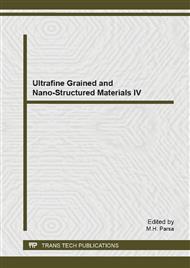[1]
L. Yu, F. Qu, X. Wu, Facile hydrothermal synthesis of novel ZnO nanocubes, J. Alloys Compd. 504 ( 2010) L1-L4.
DOI: 10.1016/j.jallcom.2010.05.055
Google Scholar
[2]
J. Li, Zhuang H. Zhuang, J. Wang, P. Xu, Fabrication and characterization of Mg-doped pencil-shaped ZnO microprisms, Appl. Surf. Sci. 257 ( 2011) 2337–2340.
DOI: 10.1016/j.apsusc.2010.09.099
Google Scholar
[3]
H.L. Yan, X.L. Zhong, J.B. Wang, S.L. Ding, G.C. Zhou, Y.C. Zhou, Spatial distribution of manganese and room temperature ferromagnetisin manganese-doped ZnO nanorods, Appl. Phys. Lett. 90 ( 2007) 082503-082506. .
DOI: 10.1063/1.2993354
Google Scholar
[4]
J. Zhong, S. Muthukumar, Y. Chen, and Y. Lu, Ga-doped ZnO single-crystal nanotips grown on fused silica by metalorganic chemical vapor deposition, Appl. Phys. Lett. 83(2003)3401-3403.
DOI: 10.1063/1.1621729
Google Scholar
[5]
S. Yun, J. Lee, J. Yang, and S. Lim., Hydrothermal synthesis of Al-doped ZnO nanorod arrays on Si substrate, Phy.B. 405(2010) 413–419.
DOI: 10.1016/j.physb.2009.08.297
Google Scholar
[6]
A. Ismardi, C. F Dee, I.C. Gebeshuber and B.Y. Majlis, Growth and Characterization of Indium Doped ZnO Nan owires Using Vapor Transport Deposition Method, Adv. Mater. Res. 364 (2012) 202-205.
DOI: 10.4028/www.scientific.net/amr.364.202
Google Scholar
[7]
S. Deka, and P.A. Joy, Synthesis and magnetic properties of Mn doped ZnO nanowires, Solid State Commun. 142 (2007) 190–194.
DOI: 10.1016/j.ssc.2007.02.017
Google Scholar
[8]
H. Li, Y.Z. Zhang, X.J. Pan, H.L. Zhang, T. Wang, E.Q. Xie, Effects of In and Mg doping on properties of ZnO nanoparticles by flame spray synthesis, J. Nanopart. Res. 11(2009) 917-921.
DOI: 10.1007/s11051-008-9487-8
Google Scholar
[9]
E. W. Seelig, B. Tang, A. Yamilov, H. Cao and R. P. H, Chang, Self-assembled 3D photonic crystals from ZnO colloidal spheres, Mate. Chem. and Phys. 80( 2003) 257-263.
DOI: 10.1016/s0254-0584(02)00492-3
Google Scholar
[10]
Z. Wei Pan1, Z. R Dai1, and Z. L Wang, Room-Temperature Ultraviolet Nanowire Nanolasers, Science. 291(2001) 1947-(1949).
Google Scholar
[11]
P.G. Li, S.L. Wang, W.H. Tang, Low-temperature synthesis and photoluminescence of ZnO nanostructures by a facile hydrothermal process, J. Alloys Compd. 489( 2010) 566-569.
DOI: 10.1016/j.jallcom.2009.09.110
Google Scholar
[12]
Q. Ahsanulhaq, S.H. Kim, Y.B. Hahn, Hexagonally patterned selective growth of well-aligned ZnO nanorod arrays, J. Alloys Compd. 484( 2009) 484: 17-20.
DOI: 10.1016/j.jallcom.2009.04.122
Google Scholar
[13]
D. Yu et al, ZnO Nanowires Synthesized by Vapor Phase Transport Deposition on Transparent Oxide Substrates, Nanoscale Res Lett. 5(2010) 1333-1339.
DOI: 10.1007/s11671-010-9649-3
Google Scholar
[14]
X.Y. Kong, Y. Ding, R.S. Yang, Z.L. Wang, Single-crystal nanorings formed by epitaxial self-coiling of polar-nanobelt, Science. 303(2004) 1348-1351.
DOI: 10.1126/science.1092356
Google Scholar
[15]
X. Wu, F.Y. Qu, X. Zhang, W. Cai, G.Z. Shen, Fabrication of ZnO ring-like nanostructures at a moderate temperature via a thermal evaporation process, J. Alloys Compd. 486( 2009) L13- L16.
DOI: 10.1016/j.jallcom.2009.06.197
Google Scholar
[16]
H.B. Zeng, W.P. Cai, P.S. Liu, X.X. Xu, H.J. Zhou, C. Klingshirn, H. Kalt, ZnO-Based Hollow Nanoparticles by Selective Etching: Elimination and Reconstruction of Metal−Semiconductor Interface, Improvement of Blue Emission and Photocatalysis, ACS Nano. 2 (2008).
DOI: 10.1021/nn800353q
Google Scholar
[17]
Xiang Yang Kong and Zhong Lin Wang, Spontaneous Polarization-Induced Nanohelixes, Nanosprings, and Nanorings of Piezoelectric Nanobelts, Nano Lett. 3(2003) 1625-1631.
DOI: 10.1021/nl034463p
Google Scholar
[18]
H.B. Chen, X. Wu, L.H. Gong, C. Ye, F.Y. Qu, G.Z. Shen, Hydrothermally Grown ZnO Micro/Nanotube Arrays and Their Properties, Nanoscale Res. Lett. 5 (2010) 570-575.
DOI: 10.1007/s11671-009-9506-4
Google Scholar
[19]
L.H. Gong, X. Wu, C. Ye, F.Y. Qu, M.Z. An, Aqueous phase approach to ZnO microspindles at low temperature, J. Alloys Compd. 501( 2010) 375-379.
DOI: 10.1016/j.jallcom.2010.04.110
Google Scholar
[20]
Zongyou Yin et al, Electrochemical Deposition of ZnO Nanorods on Transparent Reduced Graphene Oxide Electrodes for Hybrid Solar Cells, small. 6(2010) 307–312.
DOI: 10.1002/smll.200901968
Google Scholar
[21]
O. Akhavan, M. Mehrabian2, K. Mirabbaszadeh2 and R. Azimirad, Hydrothermal synthesis of ZnO nanorod arrays for photocatalytic inactivation of bacteria, J. Phys. D: Appl. Phys. 42(2009) 225305.
DOI: 10.1088/0022-3727/42/22/225305
Google Scholar
[22]
W.T. Chiou, W.Y. Wu, J.M. Ting, Growth of single crystal ZnO nanowires using sputter deposition, Diamond Relat. Mater. 12(2003) 1841–1844.
DOI: 10.1016/s0925-9635(03)00274-7
Google Scholar
[23]
K. Kitamura, T. Yatsui, M. Ohtsuand G-C. Yi, Fabrication of vertically aligned ultrafine ZnO nanorods using metal–organic vapor phase epitaxy with a two-temperature growth method, Nanotechnology. 19(2008) 175305.
DOI: 10.1088/0957-4484/19/17/175305
Google Scholar
[24]
DW. Williams and MA. Lewis, Isolation and identification of Candida from the oral cavity, Oral Dis. 6 ( 2000) 3-11.
Google Scholar
[25]
S. Suwanboon, P. Amornpitoksuk and Apinya Sukolrat, ependence of optical properties on doping metal, crystallite size and defect concentration of M-doped ZnO nanopowders (M = Al, Mg, Ti), Ceram Int. 37 (2011) 1359 1365.
DOI: 10.1016/j.ceramint.2010.12.010
Google Scholar
[26]
B. Djurisˇic´ A, and YH. Leung, Optical Properties of ZnO Nanostructures, small. 8-9( 2006) 944-961.
Google Scholar


